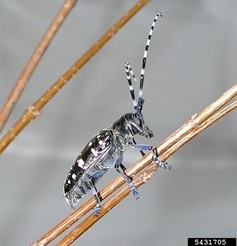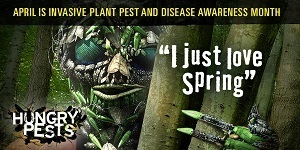|
April 10, 2019
Contact: Greg Norwood, 517-342-4514
USDA proclaims April as invasive plant pest and disease awareness month
Spring is here and many people are on the move – so are many plant and tree pests. The U.S. Department of Agriculture - Animal and Plant Health Inspection Service has designated April as invasive plant pest and disease awareness month to remind travelers to do their part to prevent the spread of these destructive invaders.
Most invasive species don’t move very far on their own. Many have made it to the U. S. by hitching a ride on goods and materials from other countries, or even on the ships, planes and trains that transport them. Once here, plant pests rely on humans to make their way from state to state.

According to USDA-APHIS, damage caused by invasive tree and plant pests coupled with the cost of control and eradication efforts can reach $40 billion annually, with losses affecting agriculture, forest products and even residential landscapes.
The Asian longhorned beetle, which likely arrived in wood packing materials from Asia, has caused the loss of more than 180,000 trees in Ohio, Massachusetts, New York, New Jersey and Illinois. The beetle and its larvae can travel unnoticed in firewood, logs or branches of infested trees.
|

Already found in Delaware, New Jersey and Virginia, spotted lanternfly is spreading through eastern Pennsylvania. These insects suck sap from stems and leaves of more than 70 plants and crops including grapes, apples, hops, walnuts and other hardwood trees.
“The departments of Natural Resources, Environmental Quality and Agriculture and Rural Development work together to detect, respond to and provide outreach about invasive species,” said Greg Norwood, the DNR’s terrestrial invasive species coordinator. “For example, we are now working hard to contain the damage from hemlock woolly adelgid in southwest Michigan and oak wilt in several counties across the state. It is important for everyone to take steps to limit the risk of introducing new pests and diseases to Michigan.”
|

Both the federal government and individual states use quarantines to restrict the movement of materials that might carry plant or tree pests and diseases. A list of quarantines affecting movement of certain products into or within Michigan can be found on the Michigan Department of Agriculture and Rural Development’s website, Michigan.gov/MDARD. Travelers can learn about pest and disease quarantines in states they plan to visit by checking the USDA-APHIS Pest Tracker at APHIS.USDA.gov.
|
These simple steps can help prevent new pests and diseases from hitching a ride with travelers, whether within our outside Michigan:
- Wash dirt and debris from outdoor gear and tires before traveling, and check cars, trailers and recreational vehicles for insects or egg masses.
- When traveling, leave firewood at home. Buy it at the destination point and burn it there.
- Check with a local USDA office before bringing home fruits, vegetables or plants from other states.
- Outside of Michigan, report any signs of invasive pests by going to Hungrypests.com.
- Within Michigan, report invasive species to the Midwest Invasive Species Information Network at MISIN.MSU.edu.
For more information on invasive species threats in Michigan, visit Michigan.gov/Invasives.
Michigan's Invasive Species Program is cooperatively implemented by the Michigan departments of Agriculture & Rural Development, Environmental Quality and Natural Resources.
/Note to editors: Accompanying photos are available below for download. Suggested captions follow:
ALB: The Asian longhorned beetle can infest several species of hardwood trees, including maple. Once infested, trees must be removed to prevent further spread. Photo credit: Melody Keena, USDA Forest Service, Bugwood.org.
Egg masses: Spotted lanternflies can deposit egg masses on any smooth surface. Masses appear putty-like and can be removed by careful scraping. Photo credit: Emilie Swackhammer, Penn State University, Bugwood.org.
Vin Vasive: USDA-APHIS’s icon Vin Vasive reminds everyone why it’s important to leave hungry pests behind./
|